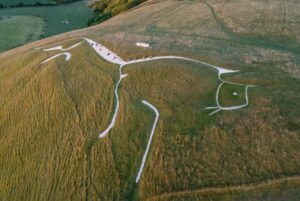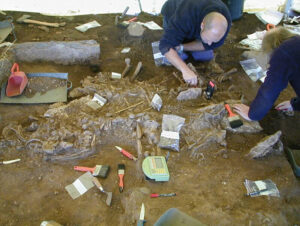Globally, wildfires are getting worse. This year alone they have ravaged Spain, Italy, Greece, Algeria, Tunisia, Canada, and the United States. Though we have seen a rise in wildfires in recent years, they are not new.
A wave of ancient wildfires tore across Southern California 13,000 years ago. They led to the extinction of large mammals including the saber-toothed cat, the dire wolf, and ancient bison from across the region. A new study links the eradication of these species with increased fires in the region that were likely started by ancient humans.

An artist’s impression of ancient bison stuck in La Brea’s natural asphalt seeps. Photo: Cullen Townsend/Natural History Museum of Los Angeles County
A mass extinction
For years, the sudden disappearance of large mammals across the globe has puzzled scientists. During the Pleistocene, large mammals were abundant. Then suddenly, between 10,000 and 50,000 years ago, they were gone.
“North America lost more than 70% of mammals weighing more than 97lbs (44kg). South America lost more than 80%, Australia nearly 90%,” Emily Lindsey, co-author of the study told Science Alert.
The research team focussed on the La Brea Tar Pits, a famous site in southern California that has preserved the bones of thousands of large mammals over the last 50,000 years. The thick tar has almost perfectly preserved the bones, providing paleontologists with unique insight.
Using radioactive dating the team analyzed 172 bones from eight species. Seven were extinct species, the eighth was a coyote that was used as a control. All seven extinct species disappeared around 13,000 years ago.

Regan Dunn (left) and Emily Lindsey with femur bones from Ice Age ground sloths discovered in the La Brea Tar Pits. Photo: Natalja Kent/Natural History Museum of Los Angeles County
The second research site was Lake Elsinore, which sits near the La Brea Tar Pits. It again showed evidence of some kind of event 13,000 years ago. Within its sediments, there are huge spikes in the charcoal particles. “Some of those spikes for those fires are just enormous, orders of magnitude more than has ever happened before,” Robin O’Keefe, lead author of the study told New Scientist.
A human problem
A combination of a warming climate, droughts, and a growing human population seems to have triggered the extinctions. Charcoal records in Lake Elsinore show that fires were uncommon, but 13,300 years ago they increased by an order of magnitude. The research team theorizes that humans are the ultimate cause.
Humans spread across North America, hunting herbivores as they did so. At the same time, the temperature in the region soared by 5.5°C, leading to a 200-year drought. As dead and dry vegetation began to pile up, the number of herbivores that could clear it declined. Humans would then burn the vegetation, starting these enormous wildfires. From this point, there was a dramatic change in dominant plant species, with fire-resistant species flourishing.

An ancient bison from the La Brae Tar Pits. Photo: Shutterstock
The study not only delves into a historic extinction event but should sound alarm bells today. “The causes and consequences of the Pleistocene extinctions in California can provide valuable context for understanding today’s climate and biodiversity crises,” said Lindsey.






